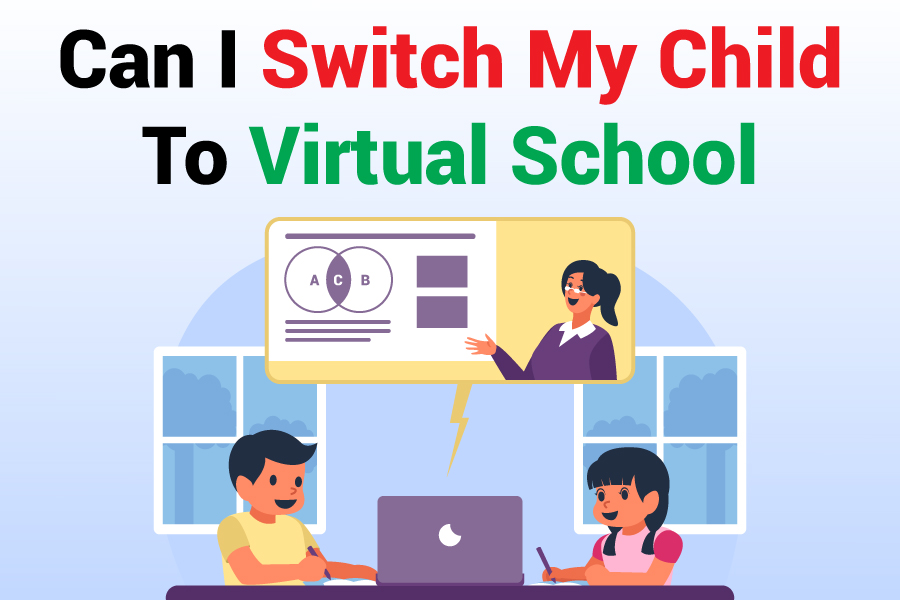As a parent, Can I switch my child to virtual school? In today’s rapidly evolving world, virtual schooling has emerged as a viable alternative to traditional brick-and-mortar schools. Virtual schools, also known as online schools or cyber schools, offer a unique learning experience that allows students to attend classes and complete assignments from the comfort of their homes or any location with an internet connection.
Virtual schooling is a form of distance learning that utilizes technology to deliver educational content and facilitate communication between teachers and students. It provides a flexible and personalized approach to learning, catering to diverse learning styles and individual needs. Whether you’re considering virtual schooling due to geographical constraints, health concerns, or a desire for a more tailored educational experience, it’s essential to understand the nuances of this educational model before making the switch.
Benefits Of Virtual Schooling
Virtual schooling offers several advantages that can benefit both students and families. One of the primary benefits is flexibility. Students can learn at their own pace and schedule, allowing them to balance their academic responsibilities with extracurricular activities, family commitments, or unique circumstances. This flexibility can be particularly advantageous for students who thrive in a self-paced learning environment or those who have special needs or medical conditions that make attending a traditional school challenging.
Another significant benefit of virtual schooling is personalized learning. With smaller class sizes and individualized attention from teachers, students can receive tailored instruction and support based on their specific needs and learning styles. This personalized approach can foster a deeper understanding of the subject matter and promote academic growth.
Additionally, virtual schooling provides access to a diverse range of courses and educational resources that may not be available in traditional schools. Students can explore subjects and electives that align with their interests and career aspirations, expanding their educational horizons.
Considerations Before Switching To Virtual School
While virtual schooling offers numerous advantages, it’s crucial to carefully consider the implications and ensure it aligns with your child’s learning style and your family’s circumstances. Here are some key factors to consider:
Self-motivation and discipline: Virtual schooling requires a high level of self-motivation and discipline from students. Without the structured environment of a traditional classroom, students must take responsibility for their learning, manage their time effectively, and stay on track with assignments and deadlines.
Parental involvement: Successful virtual schooling often requires significant parental involvement, especially for younger students. Parents may need to provide guidance, support, and supervision throughout the learning process.
Socialization opportunities: One concern with virtual schooling is the potential lack of face-to-face social interactions with peers. It’s important to explore ways to foster social connections and extracurricular activities to ensure your child’s overall development.
Technical requirements: Virtual schooling relies heavily on technology, including a reliable internet connection, computer or device, and potentially specialized software or applications. Ensure you have the necessary technical resources and support to facilitate a seamless virtual learning experience.
Steps To Switch Your Child To Virtual School
If you’ve carefully considered the pros and cons and decided that virtual schooling is the right choice for your child, here are the steps to make the transition:
- Research virtual school options: Explore different virtual school programs, curricula, and providers to find the best fit for your child’s needs and educational goals.
- Enroll and register: Once you’ve selected a virtual school, complete the enrollment and registration process, which may involve submitting transcripts, documentation, and other required materials.
- Familiarize yourself with the platform: Familiarize yourself and your child with the virtual learning platform, including how to access courses, submit assignments, and communicate with teachers and classmates.
- Establish a dedicated learning space: Create a quiet, distraction-free learning environment at home equipped with the necessary technology and resources for virtual learning.
- Develop a routine: Establish a consistent routine and schedule to help your child stay focused and organized throughout the virtual school experience.
Virtual School Curriculum And Resources
Virtual schools offer a wide range of curricula and educational resources to support students’ learning journeys. Many virtual schools follow state or national educational standards, ensuring that students receive a comprehensive and well-rounded education.
In addition to core subjects like math, science, language arts, and social studies, virtual schools often provide elective courses and specialized programs to cater to diverse interests and career paths. These may include foreign languages, art, music, computer programming, and advanced placement (AP) or honors courses.
Virtual schools also leverage various digital resources and multimedia tools to enhance the learning experience. These can include interactive lessons, virtual labs, educational videos, online simulations, and collaborative platforms for group projects and discussions.
Setting Up A Virtual Learning Environment At Home
Creating a conducive learning environment at home is crucial for the success of virtual schooling. Here are some tips to help you set up an effective virtual learning space:
- Dedicated workspace: Designate a quiet, well-lit area in your home as a dedicated workspace for your child’s virtual learning activities. This space should be free from distractions and encourage focus and productivity.
- Ergonomic setup: Ensure that your child’s workspace is ergonomically designed to promote proper posture and minimize physical strain. Consider investing in a comfortable chair, adjustable desk, and appropriate lighting.
- Technology and resources: Equip the workspace with the necessary technology, such as a computer or tablet, reliable internet connection, headphones or speakers, and any required software or applications.
- Organization and storage: Implement organizational systems and storage solutions to keep learning materials, supplies, and completed assignments organized and easily accessible.
- Comfortable and inspiring environment: Create an environment that fosters motivation and creativity. Incorporate elements that inspire your child, such as motivational quotes, artwork, or personal touches that reflect their interests.
Virtual School Vs. Traditional School: Pros And Cons
As you consider switching to virtual schooling, it’s essential to weigh the pros and cons against traditional brick-and-mortar schools. Here’s a comparison to help you make an informed decision:
Pros of virtual schooling:
- Flexibility and personalized learning
- Access to diverse courses and resources
- Potential for one-on-one attention from teachers
- Ability to learn at your own pace
- Reduced exposure to bullying or negative social pressures
- Elimination of commuting time and associated costs
Cons of virtual schooling:
- Lack of face-to-face social interactions
- Increased parental involvement and supervision
- Potential for isolation or lack of extracurricular activities
- Reliance on technology and a stable internet connection
- Potential for distractions in a home environment
- Challenges in fostering collaboration and group work
Pros of traditional schooling:
- Structured learning environment and routine
- Face-to-face interactions with teachers and peers
- Access to school facilities and resources (e.g., libraries, labs, sports facilities)
- Opportunities for extracurricular activities and social development
- Direct supervision and support from teachers and staff
Cons of traditional schooling:
- Rigid schedules and less flexibility
- Potential for negative social influences or bullying
- Commuting time and associated costs
- Limited course offerings or resources in some schools
- Potential for overcrowded classrooms or lack of individualized attention
It’s important to carefully consider these pros and cons in relation to your child’s learning style, needs, and personal circumstances to determine the best educational path.
Support Systems For Virtual Schooling
Strong support systems play an important role in helping children succeed in virtual schooling. These systems guide both academic progress and overall well-being. Here are key options to consider:
- Virtual school community:
Many virtual schools create a sense of belonging through online forums, clubs, and organized social activities. Encouraging your child to join these spaces helps them build friendships and feel connected. - Parent support groups:
Parent groups linked to virtual schools can provide helpful advice, shared experiences, and practical tips. These communities make it easier to navigate challenges and stay informed. - Virtual tutoring and academic support:
Tutoring services and subject specific help can strengthen your child’s skills. These resources are often available through the school or trusted outside providers. - Counseling and mental health resources:
Virtual learning can sometimes feel isolating. Access to counseling or mental health programs supports emotional balance and helps children manage stress. - Technical support:
Reliable technical help is essential. Make sure you have access to support for device issues, software problems, or internet concerns to keep learning running smoothly.
Common Challenges And How To Overcome Them
While virtual schooling offers many benefits, it also presents unique challenges that you and your child may encounter. Here are some common challenges and strategies to overcome them:
- Time management and procrastination: Establish a structured routine and use tools like calendars, schedules, and reminders to help your child stay on track with assignments and deadlines. Encourage breaks and reward systems to maintain motivation.
- Distractions and lack of focus: Create a dedicated learning space free from distractions and implement strategies like the Pomodoro technique (alternating periods of focused work and breaks) to improve concentration.
- Technical issues: Ensure you have access to reliable technical support and troubleshooting resources. Consider investing in backup internet connections or devices to minimize disruptions.
- Lack of social interaction: Encourage your child to participate in virtual school clubs, forums, or online study groups. Arrange in-person meetups or playdates with classmates or friends to foster social connections.
- Parental burnout: Seek support from other parents, virtual school resources, or counseling services if you feel overwhelmed. Practice self-care and establish boundaries to maintain a healthy balance.
By proactively addressing these challenges and implementing effective strategies, you can help your child overcome obstacles and thrive in the virtual schooling environment.
Virtual School Success Stories
Virtual schooling has proven successful for many students and families around the world. Here are a few inspiring success stories:
Emily, a gifted student: Emily, a highly gifted student, struggled to find the right academic challenge in her local school. After switching to virtual schooling, she was able to accelerate her learning and explore advanced courses in her areas of interest, leading to remarkable academic achievements and college acceptances.
Jacob, an athlete: Jacob, a talented athlete, found it challenging to balance his rigorous training schedule with traditional school hours. Virtual schooling allowed him the flexibility to attend classes and complete assignments around his training commitments, enabling him to pursue his athletic dreams while maintaining academic excellence.
Sarah, a student with special needs: Sarah, a student with autism spectrum disorder, faced challenges in a traditional classroom setting. Virtual schooling provided her with a personalized learning environment that accommodated her unique needs, allowing her to thrive academically and develop essential skills at her own pace.
Conclusion
Switching a child to virtual schooling is a meaningful decision that depends on their learning style, personal needs, and your family’s routine. Virtual programs offer flexibility and personalized instruction, but they also require strong focus, consistent support, and dependable technology. It is important to consider how well your child manages independent work and how the shift may influence social interaction or activities. Families asking Can I switch my child To Virtual School can find clarity by looking closely at these factors and choosing the option that supports steady growth, confidence, and long term success.












































Leave a Reply